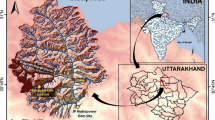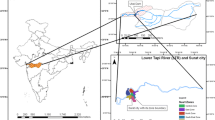Abstract
In this paper, an analytical solution is investigated in the zero-inertia problem for surge flow phenomena in non-prismatic channels considering the impact of infiltration (introduced by Technische Univ. Dresden) in dry-channels under drought and wet conditions in a semi-arid climate in Iran. The hydrodynamic analytical model introduced by Dresden University is free of numerical troubles, easy to run, computationally efficient, and fully satisfies the law of volume conservation. In a first test series, the hydrodynamic analytical ZI model can be compared favorably with a full hydrodynamic numerical model (HEC-RAS) in a permeable non-prismatic channel. In the next step, a sensitivity and error analysis was conducted and found that the Manning-Strickler coefficient, hydraulic radius, and inflow hydrograph have important effects on the velocity of the surge, suggesting the importance of an adequate description of the topography. The new approach is finally applied to simulate and compare 10 scenarios to manage artificial groundwater recharge in three channels in the downstream of Garin Dam under wet (more than 25%) and drought (less than 5%) conditions in the west of Iran. Based on tested scenarios, infiltration rate of bad and suitable scenarios varies from 3 to 85% and 1 to 76% of the total volume of released water in Garin in wet and drought phases, respectively.



Similar content being viewed by others
References
Asano T (1985) Artificial Recharge of Groundwater, Butterworth Publishers. 767 p
Azaroual M, Pettenati M, Ollivier P, Besnard K, Casanova J, Rampnoux N (2013) Reactive Transfer of Pollutants Through the Unsaturated Soil Zone During an Artificial Aquifer Recharge Process. J Procedia Earth and Planetary Science 7:40–43
Battashi N, Rashid Ali S (1998) The role of Artificial Recharge schemes in water resources development in Oman. Internal Paper, the Ministry of Water Resources, Sultanate of Oman
Borja M, Zema D, Romero B, Moya D, Heras J (2018) Short-term changes in infiltration between straw mulched and non-mulched soils after wildfire in Mediterranean forest ecosystems. J Ecological Engineering 122:27–31
Bouwer H (2002) Artificial Recharge of Groundwater: Hydrogeology and engineering. Hydrogeol J. https://doi.org/10.1007/s10040-001-0182-4
Brunner GW (2002) HEC-RAS River analysis system, Hydraulic Reference Manual. Hydrologic Engineering Centre of USACE
Dagbegnon C, Sohoulande D (2017) Bridging drought and climate aridity. J Arid Environ 144:170–180
Dong H, Huang R, Gao Q (2017) Rainfall infiltration performance and its relation to mesoscopic structural properties of a gravelly soil slope. J Eng Geol 230:1–10
Elhanafy H, Copeland GJM (2007) Flash floods simulation using saint venant equations. Proc. of the 12th ASAT Conf., Cairo
Ferrero A, Segalini A, Umili G (2015) Experimental tests for the application of an analytical model for flexible debris flow barrier design. J Eng Geol 185:33–42
Ghasempour F, Liedl R, Schmitz GH, Volker R (2003) Analytical solution to the zero-inertia problem for surge flow phenomena in non-prismatic channels with considering infiltration. Ph.D. thesis, Deresden University, Germany. (unpublished)
Ghosh S, Santosh H, Shiva K, Pudasainic P (2018) On analytical solutions of a two-phase mass flow model. Nonlinear Analysis: Real World Applications 41(2):412–427
Gosling SN, Zaherpour J, Mount N, Hattermann FF, Dankers R, Arheimer BD, Kundu D (2017) A comparison of changes in river runoff from multiple global and catchment-scale hydrological models under global warming scenarios of 1 C, 2 C and 3 C. J limatic Change 141(3):577–595
Hardie M, Cotching W, Doyle D, Holz G, Lisson S, Mattern K (2011) Effect of antecedent soil moisture on preferential flow in a texture-contrast soil. J Hydrol 398(3–4):191–201
Henderson FM (1966) Open channel flow. Macmillan, New York
Jaynes DB (1986) Simple model of border irrigation. J Irrig and Drain Engrg, ASCE 112(2):172–184
Haimerl G, Zunic F (2002) Infiltration test and numerical solution to evaluate the efficiency of Infiltration in arid countries. 3’rd International Conf. on water res. and Env. Research, TU Dresden
Haimerl G (2004) Groundwater recharge in wadi channels downstream of dam, efficiency, and management strategies. Ph.D. Thesis, Institute of hydraulic and water resources engineering, TU München, Germany. (unpublished)
Katopodes ND, Strelkoff T (1977) Hydrodynamics of border-irrigation: Complete model. J Irrig Drain Eng, ASCE 103(3):309–324
Kowsar A (1991) Flood Water Spreading for Desertification Control: An Integrated approach. Des Con Bull 19:3–18
Kowsar A (1996) An introduction to flood at mitigation and optimization of flood water utilization: Flood irrigation, artificial recharge of groundwater, small earth dams. (In Persian, the English translation is in the press). Ministry of Jihad-e-Sazandegi, Tehran
Lanzoni M, Darling WM, Edmunds WM (2018) Groundwater in Sudan: An improved understanding of wadi-directed recharge. J Appl Geochem 99:55–64
Martinez A, Folch A, Torrento C, Valhondo C, Barba C, Domenech C, Soler A (2018) Monitoring induced denitrification during managed aquifer recharge in an infiltration pond. J Hydrol 561:123–135
Ouyangab C, Heab S, Tangc C (2015) Numerical analysis of dynamics of debris flow over erodible beds in Wenchuan earthquake-induced area. Eng Geol 194:62–72
Philipp A, Schmitz G, Liedl R (2010) Analytical Model of Surge Flow in Nonprismatic Permeable Channels and Its Application in Arid Regions. J Hydraul Eng:290–298. https://doi.org/10.1061/(ASCE)HY.1943-7900.0000172
Rahman M, Moser A, Anderson M, Zhang C, Rotzer T, Pauleti S (2019) Comparing the infiltration potentials of soils beneath the canopies of two contrasting urban tree species. J Urban ForestryandUrban Greening 38:22–32
Scherrer S, Naef F (2003) A decision scheme to indicate dominant hydrological flow processes on temperate grassland. J Hydrological Processes 17(2):391–401
Schmitz GH, Liedl R, Volker R (2002) Analytical solution to the zero-inertia problem for surge flow phenomena in non-prismatic channels. J Hydraul Eng 128(6):604–615
Schmitz GH, Seus GJ (1987) Analytical solution of simplified surge flow equations. J Irrig Drain Eng, ASCE 113(4):605–610
Schmitz GH, Seus GJ (1990) Mathematical zero-inertia modeling of surface irrigation: Advance in borders. J Irrig and Drain Engrg, ASCE 116(5):603–615
Schoonover J, Crim J (2015) An Introduction to Soil Concepts and the Role of Soils in Watershed Management. J Contemporary Water Research and Education 154(2):21–47
Strelkoff T, Katopodes ND (1977) Border-irrigation hydraulics with zero inertia. J Irrig and Drain Engrg, ASCE 103(3):325–342
Whitham GB (1955) The effects of hydraulic resistance in the dam-break problem. Proc Royal Soc London, A 227:399–407
Wu GL, Liu Y, Yang Z, Cui Z, Deng L, Chang XF, Shi Z (2017) Root channels to indicate the increase in soil matrix water infiltration capacity of arid reclaimed mine soils. J Hydrol 546:133–139
Author information
Authors and Affiliations
Corresponding author
Ethics declarations
Conflicts of Interest Statement
The authors whose names are listed immediately below in this manuscript certify that they have no affiliations with or involvement in any organization or entity with any financial interest or non-financial interest regarding the subject and materials discussed in this manuscript.
Additional information
Publisher’s Note
Springer Nature remains neutral with regard to jurisdictional claims in published maps and institutional affiliations.
Rights and permissions
About this article
Cite this article
Nouri, H., Ghasempour, F. An Experimental Test for Application of Analytical Model of Surge Flow under Drought and Wet Conditions in a Semi-Arid Region. Water Resour Manage 33, 1969–1983 (2019). https://doi.org/10.1007/s11269-019-02222-x
Received:
Accepted:
Published:
Issue Date:
DOI: https://doi.org/10.1007/s11269-019-02222-x




